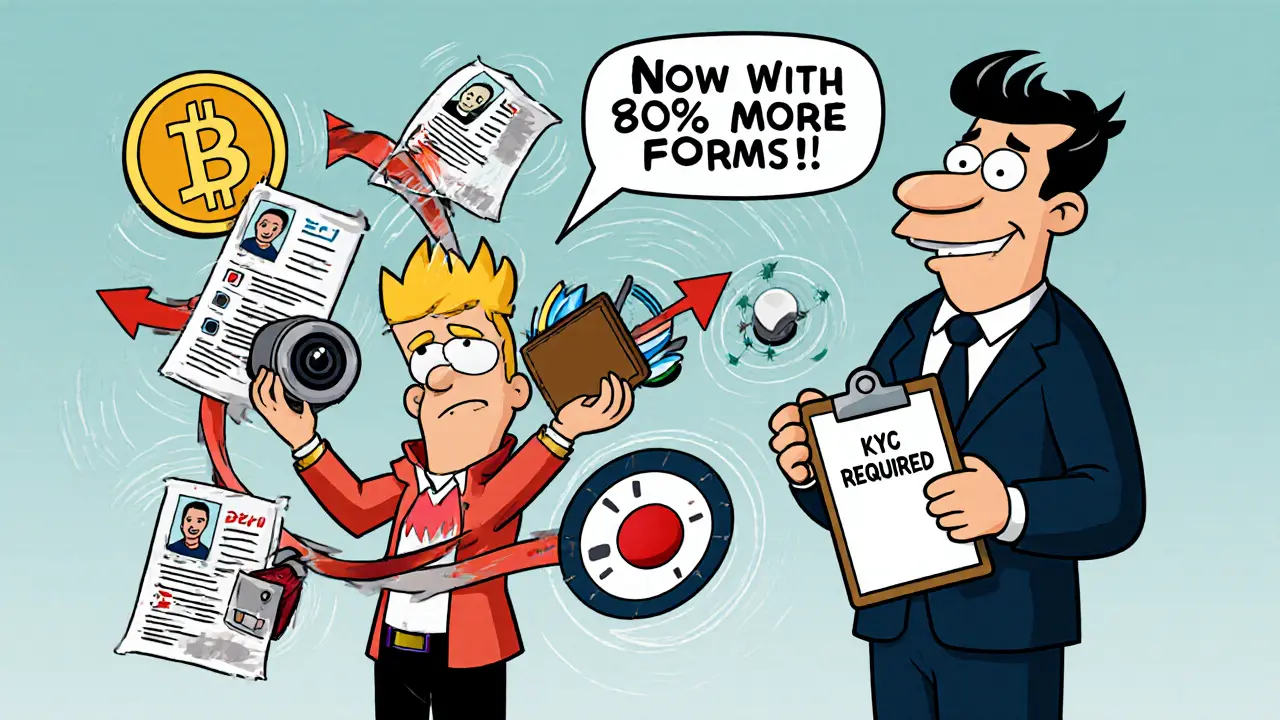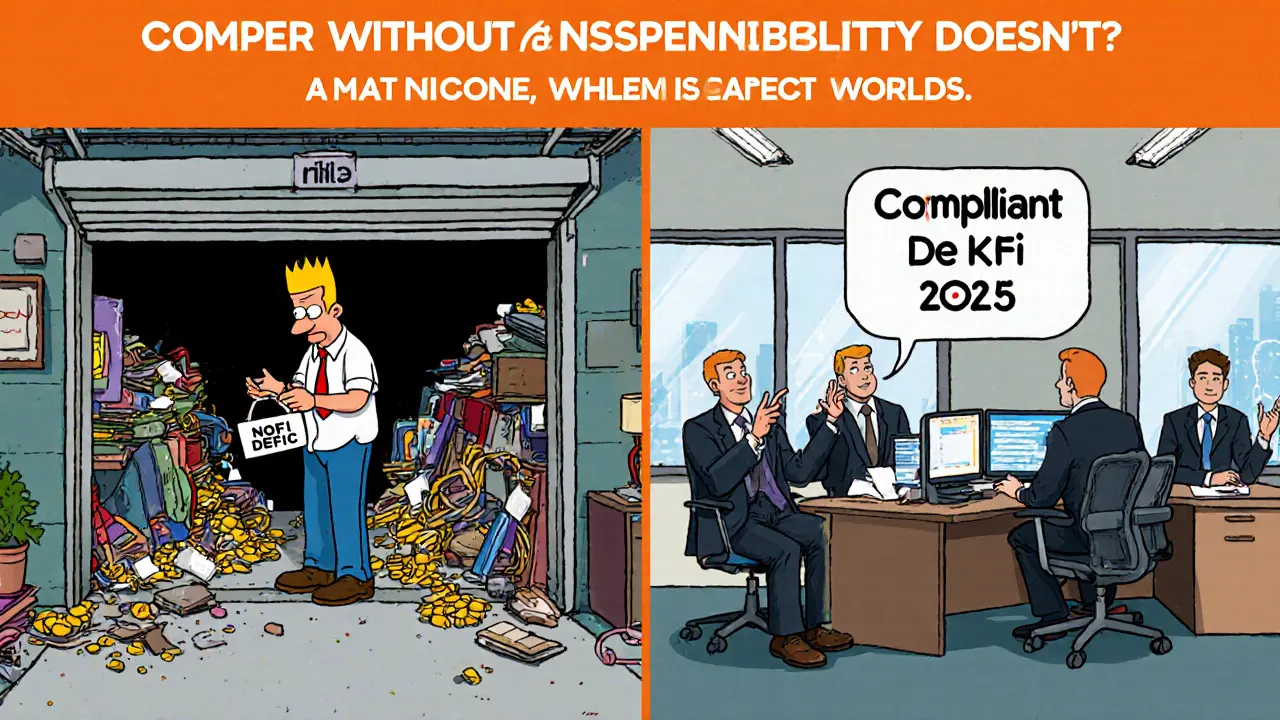DeFi Compliance Cost Calculator
Compliance Cost Estimator
Estimate the implementation costs for regulatory compliance based on your DeFi project's scale and requirements.
DeFi was built to be free from banks, but now it’s being forced to act like one
Decentralized Finance promised a world where you could lend, borrow, and trade without asking anyone’s permission. No paperwork. No identity checks. Just code and crypto. But as of 2025, that dream is colliding with reality. Regulators aren’t asking DeFi to change-they’re demanding it. And the pressure is mounting fast.
The European Union’s MiCA is the Markets in Crypto-Assets Regulation, a comprehensive legal framework that now requires DeFi platforms to meet strict transparency, governance, and cybersecurity standards is just the beginning. The U.S. SEC is cracking down on custody violations. The Financial Action Task Force (FATF) now enforces the Travel Rule on DeFi protocols. And blockchain analytics firms like Chainalysis a leading blockchain analytics company that tracks crypto transactions for regulatory compliance and law enforcement and Elliptic a blockchain intelligence platform used by financial institutions to detect illicit crypto activity are being hired by protocols to monitor every transaction.
This isn’t about shutting down DeFi. It’s about forcing it to grow up. And that’s messy.
Why DeFi can’t just ignore regulators
Some DeFi users still believe they can operate in the shadows. They think, "It’s just smart contracts. No one owns it. So who’s responsible?" That thinking is outdated-and dangerous.
Regulators don’t care if a protocol is decentralized. They care about who’s benefiting from it. If a DeFi platform has 100,000 users sending money across borders, regulators will treat it like a bank. And they’ve got tools now to trace those transactions.
The FATF Travel Rule a global AML standard requiring Virtual Asset Service Providers to share sender and receiver information for transfers over $1,000 is the biggest wake-up call. It used to apply only to centralized exchanges. Now, under 2025 updates, it applies to DeFi aggregators, lending protocols, and even decentralized exchanges that handle large volumes. If you’re moving $5,000 from one wallet to another through a DeFi app, that transaction must now carry identifiable data-or it gets blocked.
And it’s not just about money laundering. The SEC’s Custody Rule a U.S. regulation requiring investment advisors to hold client assets with qualified third-party custodians is a nightmare for DeFi. Most DeFi users store assets in self-custodied wallets. But if you’re a fund manager using DeFi to invest client money, the SEC says you’re breaking the law unless you use a regulated custodian. Galois Capital learned that the hard way in 2024-fined $225,000 for holding client crypto in non-compliant wallets.
The technical nightmare: Compliance in a permissionless world
Imagine trying to install a security camera on a moving train while the train is still being built. That’s what compliance looks like for DeFi.
Smart contracts are immutable. Once deployed, they can’t be changed. But regulations change all the time. So how do you update compliance rules in code that’s already live on the blockchain? You can’t. That’s why most protocols now rely on off-chain KYC systems-users verify their identity before they even connect their wallet.
But here’s the catch: if you require KYC, you’re no longer decentralized. You’re a centralized gatekeeper with a blockchain front-end. And that defeats the whole point.
Then there’s cross-chain laundering. Bad actors move funds from Ethereum to Solana to Polygon to avoid detection. Each chain has different rules. Some don’t even have AML tools. Regulators can’t keep up. But compliance teams can-and they’re building tools to track those movements. AI-powered transaction monitoring a system using machine learning to detect patterns in crypto transactions that signal money laundering or fraud is now standard for serious DeFi projects. These systems flag suspicious behavior: rapid transfers between wallets, mixing through privacy protocols, or sudden large inflows from newly created accounts.
And it’s not just about money. Oracle manipulation an attack where fake price data is fed into a DeFi protocol to trigger malicious trades or liquidations is a growing compliance risk. If a DeFi lending platform uses a manipulated price feed to liquidate a user’s position, that’s not a bug-it’s a regulatory violation. Who’s liable? The protocol? The oracle provider? The governance token holders who voted to change the price source? No one knows yet. But regulators will demand answers.

Who’s paying the price?
Small DeFi projects are getting crushed.
Implementing full compliance isn’t just a matter of adding a KYC button. It requires legal teams, blockchain developers, cybersecurity experts, and ongoing audits. The cost? $500,000 to $2 million over 12-24 months, depending on complexity. Most early-stage DeFi teams don’t have that kind of cash. So they either shut down, get acquired, or get ignored by regulators until it’s too late.
Meanwhile, big players like Aave, Compound, and Uniswap are hiring former bank compliance officers and building custom RegTech stacks. They’re not just surviving-they’re positioning themselves as the compliant alternatives to centralized exchanges.
And it’s working. Institutional investors are starting to dip their toes back into DeFi-but only if they can prove compliance. Hedge funds, family offices, and even some banks now require their DeFi partners to show proof of AML controls, insurance coverage, and third-party audits. If you can’t show it, you’re out.
The user experience is breaking
Remember when you could connect your wallet and start swapping tokens in 30 seconds? That’s gone.
Now, many DeFi apps require:
- Government ID upload
- Proof of address
- Live facial verification
- Geolocation checks
- Transaction limits based on your risk score
Reddit threads are full of users frustrated by this. "I moved to DeFi to escape banks," one user wrote. "Now I’m filling out the same forms I hated before. What’s the point?"
And it’s worse for international users. A person in Nigeria might be blocked because their ID doesn’t match the system’s database. A user in Brazil might be flagged because their IP doesn’t align with their wallet’s transaction history. These aren’t bugs-they’re features of compliance systems built for Western regulatory norms.
Worse still: AI-generated phishing attacks are targeting new DeFi users. Deepfake videos of popular DeFi founders asking for wallet access. Fake KYC portals that steal private keys. Users who don’t understand blockchain are easy prey. And now, protocols are expected to educate them-or face fines.

What’s next? The future of compliant DeFi
DeFi won’t disappear. But it will change.
The next wave of successful protocols won’t be the most innovative. They’ll be the most compliant. That means:
- Hybrid architectures: decentralized core, centralized compliance layer
- Regulatory sandboxes: working with governments to test compliance tools in controlled environments
- Standardized compliance protocols: think of it as a universal KYC passport for crypto
- On-chain identity solutions: like Worldcoin or Polygon ID, where users control their verified identity without giving up privacy
Some believe the answer is self-regulation. Others think governments will force full centralization. The truth? It’s a messy middle ground.
DeFi will survive-but only if it stops pretending it can exist outside the real world. The technology is powerful. But power without responsibility doesn’t last. Regulators aren’t the enemy. Ignoring them is.
Frequently Asked Questions
Is DeFi illegal now?
No, DeFi isn’t illegal. But many DeFi activities now fall under existing financial regulations. Operating without KYC, AML controls, or custody compliance can lead to fines, shutdowns, or criminal charges-especially if you’re serving users in the EU, U.S., or other regulated jurisdictions.
Do I need to do KYC to use DeFi?
It depends on the platform. Small, obscure protocols might still let you in without verification. But major DeFi apps like Uniswap, Aave, and Curve now require KYC for users above certain transaction thresholds. If you’re a retail user doing small trades, you might still avoid it-but if you’re moving large sums or using DeFi as part of a business, KYC is mandatory.
What happens if I use a DeFi protocol that gets shut down?
Your funds aren’t automatically lost, but you may lose access to the interface or services. Smart contracts still run on the blockchain, so your assets are technically still yours. But if the protocol’s frontend is taken down or its governance is frozen, you’ll need to interact directly with the contract-something most users can’t do. Always use wallets you control and keep backups of your private keys.
Can DeFi ever be truly decentralized and compliant?
Not in the way early adopters imagined. True decentralization means no one controls anything. But compliance requires accountability. The compromise is "regulated decentralization"-where the protocol’s core functions remain on-chain and permissionless, but user onboarding, identity verification, and transaction monitoring happen off-chain under legal oversight. It’s not perfect, but it’s the only path forward.
Are there any DeFi projects doing compliance right?
Yes. Aave has partnered with Chainalysis and built a compliance layer for institutional users. Compound offers a regulated lending product through its subsidiary. Circle, the issuer of USDC, works closely with regulators to ensure its stablecoin meets global AML standards. These aren’t perfect, but they’re the closest thing to compliant DeFi we have today.
What should I do if I’m a DeFi developer?
Start by mapping your protocol against MiCA, FATF, and SEC guidelines. Hire a compliance consultant familiar with blockchain. Build KYC into your onboarding flow early. Use blockchain analytics tools to monitor for suspicious activity. Don’t wait for regulators to come to you-proactive compliance is your only defense.

ty ty
November 12, 2025 AT 03:56tom west
November 13, 2025 AT 21:49